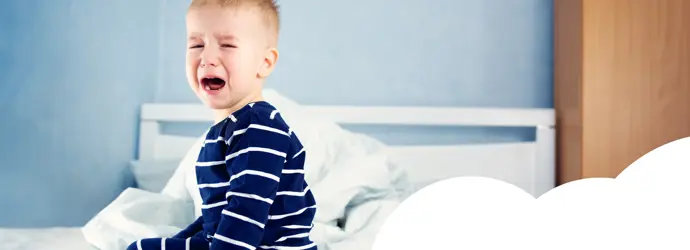113 people found this helpful

There are “TGI” Fridays, when you’re practically crying with happiness because the weekend is calling! And there are “Very Sad” Fridays, slumped in your office chair, fighting back tears because you’ve just had another meeting added to your afternoon. But nobody should be crying at their desk, and sometimes, you just need a little break to clear your mind—your colleagues will survive without you for five minutes while you take yourself off for a cup of coffee and a cake.
While you're wondering where those stress tears came from – mid-chomp of that delicious, squidgy sponge – you might also want to know the answers to: ‘why do we cry when we are sad or tired?’, and ‘what is crying with happiness?’ Well, we’re here with all the answers.
To begin, here are the top ten answers to the age-old question, “why do humans cry?”:
- Happiness.
- Relief.
- Stress.
- Exhaustion.
- Anger.
- Physical pain.
- Hurt feelings.
- Disappointment.
- Sadness, including loss.
- Empathy.
So, from shedding angry tears to crying with happiness, read on to understand a little more about what does crying do and what does crying mean.
Life can be overwhelming, so it’s important to take time to look after yourself. Fortunately, it's easy to take a moment for yourself every day thanks to Cushelle Quilted toilet paper, offering a soft and skin-loving clean* every time. Why? Because you deserve it!
What is crying?
What does crying do? Crying is a biological mechanism for your body to get a release from an overwhelming emotion, whether this is hysterical laughter or intense sadness. As well as being a way to self-soothe1, it is also a signal to others that we might be in danger or distress which hopefully then encourages them to offer help or affection when we need it the most.
Dr Raj Arora says: “Crying is a normal human reaction and releasing your emotions can often make you feel a lot better! However, tears and constant crying can sometimes be a result of a low mood. If you are feeling persistently tearful or if you’re having sad thoughts that you cannot distract yourself from then it is important to reach out to your doctor/GP or health professional for advice.”
Why do we cry?
From emotional tears when grieving at funerals to outbursts of joy because your manager approved your presentation slides with no amends, crying is an emotional response. It’s also most often associated with sadness. However, when answering what does crying mean, crying is not exclusively reserved for grief and sorrow, so let’s get into the ten reasons to help you understand the answer to the question, “why do people cry?”
1. Crying with happiness
Let’s start on a positive note! Every once in a while, you’ll experience a happy emotion that prompts tears of joy. Crying with happiness is often linked to love and personal connection. For example, you wouldn’t be too surprised to see many tears shed at a wedding. And let’s be honest, it doesn’t stop there. Some of you might find yourself crying at seemingly anything: the puppy crossing the road in his little welly boots, the cheerful elderly person on the bus, the coffee (and the cake) bought for you by your favourite colleague. It all depends on how attuned you are to your emotions!
2. Relief
This is slightly different from purely crying with happiness; often we will cry when we reach a point of contentment after a long stretch of stress or unhappiness. From anxiety about an upcoming employee review to the stress of a burst water pipe at home, reaching the end of any period of tension or strain is emotional. The relief that surfaces as soon as the problem goes away can often result in entirely natural tears.
3. Stress
Before relief, comes stress – and sometimes it’s not only when the tension lifts that we cry, but while we are under duress too. We’ve all had those horrible feelings of worry or tension that build up internally, whether from pressures at work, personal relationships, or major life changes.
The good news is that crying from stress gives us a release of this build-up and can help us to think more clearly afterwards.2 The effects of your crying may not be felt immediately but give it a little time and it should help you feel a release and help lift your mood.
4. Exhaustion
Why do people cry at unexpected things? After a long day, or a sleepless night, we’re more vulnerable to strong emotions, as our brains need to focus on keeping us awake, and this can trigger tears. Situations that wouldn’t otherwise bother us, do, and put simply, we lose the ability to maintain emotional control.3 So, if you’re wondering why do I cry easily when I get home from work at 9pm and a picture of a puppy in socks has you sobbing, you’re not going nuts – you probably just need a rest – and a holiday! (We’ve heard from a reliable source that Australia is pretty nice this time of year...)
5. Anger
Angry crying can happen at the most annoying moments: during arguments when you want to appear strong or when you’re trying to stay calm under pressure. Why do people cry when they’re angry? Anger is linked to fear, but also to the feeling of being hurt. It’s completely natural – and actually quite mature – to deal with anger through tears instead of through lashing out.4
6. Physical pain
Crying when in physical pain is an evolutionary feature. In the same way that babies cry to indicate that something is wrong, crying when physically hurt signals to everyone around us that we need help as well as giving us a way to self-soothe and cope with the physical pain that we are feeling.1
7. Hurt feelings
Though many of us find involuntary tears during an argument a little embarrassing, we shouldn’t! Similar to when we cry due to physical pain, emotional and mental pain can cause us to cry too. If a loved one has said or done something to make us feel betrayed, crying is an instant way of showing them that they need to take our distress seriously. Why do we cry when we get hurt, if not to get a little help and sympathy?
8. Disappointment
Disappointment often comes from the same source of feelings of anger: a powerful emotion when our expectations are not met. Whether it is well placed or not, disappointment can be a bitterly uncomfortable emotion, so it’s no wonder that we often express it through tears.
9. Sadness and loss
Crying is one of the best ways we can cope with feelings of sadness or loss. Although the causes of these emotions might not go away, expressing them can make you feel better in time. Witnessing tears can also bring out empathy in others.5 This means that people who see that you’re crying will give you some much-needed comfort and support. Why do we cry when we get hurt, if not to get a little help and sympathy after all.
10. Empathy
Empathetic crying – sharing the feelings of another person – is bittersweet. Though the situation may be bad, feeling sad on behalf of someone else is a wonderful part of human nature. It’s also the kind of empathy that makes us tear up when watching certain films.
So, why do humans cry? Now you have the answer! Crying is normal, healthy, and even biologically sensible. The reality is we don’t have much control over it, and we’re never going to be able to avoid this natural reflex completely. So, no need to question ‘why do I cry easily?’ or whether you’re crying with happiness or frustration! You’re no good to anyone else until you’re good to yourself, so give yourself a little break, lock yourself away whenever you need to, and let it all out!
*To verify claims, please email verify.uk@essity.com for full verification details.
Sources:
1 Is crying a self-soothing behaviour? National Library of Medicine
2 Using Crying to Cope: Physiological responses to stress following tears of sadness, National Library of Medicine
3 Why do we get more emotional when we’re tired? Science Focus
4 Temper Tantrums, National Library or Medicine
5 Stop crying! The impact of situational demands on interpersonal emotion regulation, National Library of Medicine
Related articles
10 feminine hygiene tips you may not know
Need feminine hygiene advice for yourself or your child? This is a feminine-care resource for women of all ages. Click here to find out more.

Simple yet decadent home spa ideas to help you unwind
Need some pampering? You can treat yourself at home by creating your own DIY home spa. From treatments to setting the scene, discover spa night ideas here.

How to relieve dry or watery eyes at night
Ever wondered ‘Why are my eyes watery at night?’ Discover why how to relieve your symptoms, here.

Sinusitis without a cold? Symptoms and tips for relief
Got sinusitis but no cold symptoms? Fortunately, you can get some relief. Check out sinusitis infection without a cold treatment tips here.

How to relieve sore watery eyes
When you’ve got watery eyes and a cold you can find some relief. Discover our tips on dealing with a runny eyes with a cold, here.

How to get over a persistent cough
Need help figuring out how to get over a persistent cough? Find out how to stop constant coughing, and some home remedies for persistent coughs, here.




